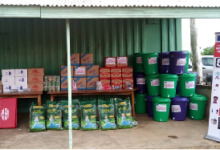
We read your articles on chemoprevention and breast cancer. Cervical cancer is another common cancer in women. Is chemoprevention applicable?
Interesting feedback! Cervical cancer represents the second leading cause of death in women worldwide- about 569,847 new cases and 311,365 attributable deaths in 2018.
The highest incidence is in low and middle-income countries, particularly in Sub-Saharan Africa; it is the second most common female malignancy.
Ghana has about 9.5 million women aged 15 years and older at risk of developing cervical cancer. Every year about 2800 women are diagnosed with cervical cancer, and about 1700 die from the disease. Cervical cancer ranks as the 2nd most frequent cancer among women in Ghana and the 2nd most frequent cancer among women between 15 and 44 years of age.
Infection of the cervix by a high-risk Human Papillomavirus (HPV), a common sexually transmitted disease, is necessary for the development of cervical cancer. In West Africa, about 4.3% of women harbour cervical HPV16/18 infection at a given time. About 55.6% of women with invasive cervical cancers are from HPVs 16 or 18 (ICO/IARC Information Centre on HPV and Cancer, 2021).
Mortality due to cancer may double in the next 50 years, rising to 15 million by 2020- thus the need for all efforts to curb the cancer menace.
The two primary methods for the prevention of cervical cancer are anti-HPV vaccination and cervical cancer screening. HPV vaccination prevents over 95% of HPV infections with HPV16 and HPV18 types. Screening detects the early curable phase of cancer, decreasing the mortality associated with cervical cancer. In under-developed countries with challenges of access to screening and vaccination, about nine out of ten women (89%) die from cervical cancer.
Clinical staging of the disease follows the diagnosis of cervical cancer to determine the most appropriate treatment. The degree of disease progression is measured from 0 to IV, with 0 as the pre-cancerous/non-invasive stage and IV as when tumor cells are present in certain body areas.
Although this disease is largely preventable, this type of cancer occurs in low-income or middle-income countries because of a lack of screening and HPV vaccination programs.
Diet has a significant impact on specific neoplasia, especially one with high content of phytochemicals. Polyphenols induce apoptosis in HPV cells, inhibit DNA synthesis and arrest growth arrest, and modulate signal transduction pathways. These phytochemicals defend the body against oxidative stress through antiproliferative, antineoplastic, and anti-inflammatory activities (Dretcanu et al. The Involvement of Natural Polyphenols in the Chemoprevention Cervical Cancer. Int. J. Mol. Sci. 2021, 22, 8812).
Although HPV is the main underlying factor in cervical cancer, HPV infection is not sufficient to induce cancer. Other factors have to be involved in the progression of infected cells to total-blown cancer. Oxidative stress promotes HPV-initiated carcinogenesis. Oxidative stress is known to upset the cellular redox status, thus leading to alteration of gene expression responses by activating several redox-sensitive transcription factors. This signaling cascade affects both cell growth and cell death. The ability of naturally occurring antioxidants to modulate cellular signal transduction pathways through the activation/repression of multiple redox-sensitive transcription factors form the basis of polyphenols for chemoprevention in cervical cancer.
In addition to acting as antioxidants, polyphenols display a wide variety of biological functions, including induction of apoptosis, growth arrest, inhibition of DNA synthesis, and modulation of signal transduction pathways. They can interfere with each stage of carcinogenesis initiation, promotion and progression to prevent cancer development (
F. Di Domenico et al. Antioxidants in cervical cancer: Chemopreventive and chemotherapeutic effects of polyphenols. BiochimicaetBiophysicaActa 1822 (2012) 737–747).
Cervical cancer is 2nd cancer among women worldwide, especially in the least developed countries. Even if the screening methods are available for early diagnosis and treatment of this neoplasia, it still represents a significant public health problem. Various natural polyphenols have shown cytotoxic effects on human cervical cancer cell lines, providing new perspectives in drug development against cervical cancer. Natural polyphenols are bioactive compounds that have demonstrated anticarcinogenic, anti-inflammatory, and antioxidant properties.
Dietary polyphenols hold potential in the prevention and therapy of cervical cancer. Polyphenols inhibit the proliferation of HPV cells through induction of apoptosis, growth arrest, inhibition of DNA synthesis, and modulation of signal transduction pathways (Marius AlexandruMoga. The Role of Natural Polyphenols in the Prevention and Treatment of Cervical Cancer—An Overview. Molecules 2016, 21, 1055; doi:10.3390/molecules21081055).
Another benefit of polyphenols is the synergy they demonstrate with chemotherapy and radiotherapy in persons with cervical cancer. Polyphenols reduce chemoresistance in persons receiving cisplatin and epirubicin for cervical cancer. They also reduce side effects in persons receiving paclitaxel. Polyphenols reduce radiation resistance in persons receiving radiotherapy for cervical cancer.
It may very well be that early use of polyphenol-rich cocoa could be a chemopreventive approach against cervical cancer in the country. Polyphenol-rich cocoa could be beneficial in combination with other forms of therapy in persons receiving treatment for cervical cancer.
BY DR. EDWARD O. AMPORFUL
CHIEF PHARMACIST
COCOA CLINIC







